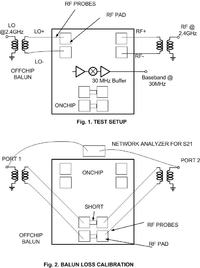analog_chip
Full Member level 1

- Joined
- Oct 9, 2011
- Messages
- 99
- Helped
- 1
- Reputation
- 2
- Reaction score
- 1
- Trophy points
- 1,288
- Activity points
- 1,994
Hi,
I want to plan test setup of my receiver. My receiver needs RF+ , RF- , LO+, LO- which I am generating using offchip baluns and introducing inside chip using RF probes as in Fig. 1.
1. I want to calibrate balun/probe loss because I want to subtract it from my total RX noise figure. I have a plan as shown in Fig. 2 where I want to measure the S21, find half the loss and remove it from total NF. The pads are identical, close and shorted. Is that OK? Has anyone better suggestion?
2. I have a baseband buffer @ 30MHz . The input is obviously not matched to 50 ohm. Is it necessary to match the output to 50 ohm @ 30 MHz since it will drive 50 ohm instruments.
3. I want to calibrate the NF and gain of the buffer and hence I have a lonely version. Is it required to matched I/P and O/P at 30 MHz now?

I want to plan test setup of my receiver. My receiver needs RF+ , RF- , LO+, LO- which I am generating using offchip baluns and introducing inside chip using RF probes as in Fig. 1.
1. I want to calibrate balun/probe loss because I want to subtract it from my total RX noise figure. I have a plan as shown in Fig. 2 where I want to measure the S21, find half the loss and remove it from total NF. The pads are identical, close and shorted. Is that OK? Has anyone better suggestion?
2. I have a baseband buffer @ 30MHz . The input is obviously not matched to 50 ohm. Is it necessary to match the output to 50 ohm @ 30 MHz since it will drive 50 ohm instruments.
3. I want to calibrate the NF and gain of the buffer and hence I have a lonely version. Is it required to matched I/P and O/P at 30 MHz now?


